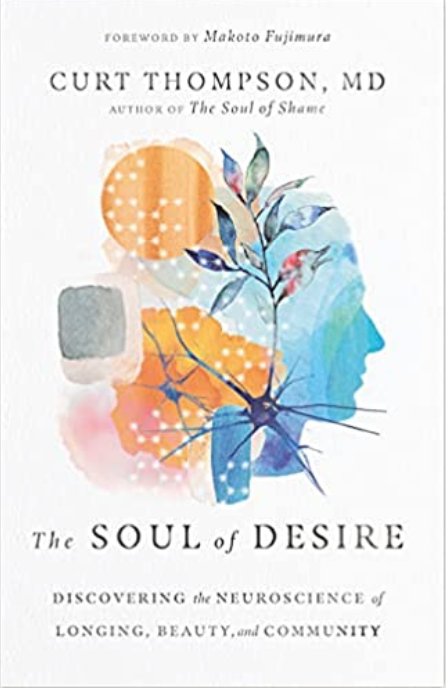For those unfamiliar with the writings of Curt Thompson, M.D, he is a Christian psychiatrist that writes at the intersection of faith, neuroscience, and interpersonal neurobiology. What follows are what I consider some of the key points made in the book and a few person musings. I am particularly interested in the role interpersonal neurobiology plays in Christian community and formation. I highly recommend The Soul of Desire to those longing for a deeper understanding of formational community. (Published by Intervarsity Press, 2021.)
“Good literature,” Dr. Curt Thompson writes, “like all meaningful art, helps us access the beauty of what it means to dwell in the house of the Lord all the days of our lives.” These words, written by Makoto Fujimura in the foreword, offer a foretaste of the feast prepared for us in The Soul of Desire: Discovering the Neuroscience of Longing, Beauty, and Community by Curt Thompson, MD. He concludes, “This book is a work of art to behold, to gaze upon, to commune with.”
Indeed.
The intersection of neuroscience, interpersonal neurobiology, and spiritual formation has long been a source of personal interest and curiosity to me. However, until now, I lacked the words and framework to make sense of it all. In The Soul of Desire, Thompson is a trustworthy guide, helping us understand the place of desire, beauty, and community in our lives as individuals and in the broader kingdom of God.
What follows are some of the concepts introduced in the book so that readers might consider their application in spiritually formative relationships and community.
Desire, Beauty, and Community
Born into the Roman Catholic Church and after spending the last 40-plus years in various Bible-believing churches, ranging from black Pentecostal to Anglican churches to non-denominational churches — I can say to the best of my remembrance that I have never heard a sermon on the positive role desire plays in our spiritual formation. Conversely, I have heard numerous sermons on the “dangers of desire,” often referring to sexual lust and sin.
Drawing on the writings of James K.A. Smith, Thompson points out that “Desire does not exist merely as some independent phenomenon to which we respond; it is also something that, like any good gardener knows, must be pruned. It must be shaped and will be shaped by whatever practices, habits, or (in Smith’s language) liturgies we develop—liturgies we practice whether we know it or not.”
Thompson’s focus on desire was not explorational of a theology of desire; instead, he focused on its interpersonal neurobiological features. In the book, we see this play out in stories drawn from Thompson’s therapeutic work with individuals and what he calls “confessional communities.”
Confessional communities, led by therapists, consist of gatherings of 6-8 people where individuals are “seen, soothed, safe, and secure” while they explore their desires, trauma, and grief. Group members play a part in creating beauty from their pain and unmet desires. Patients get to share their stories and be a part of each other’s healing.
“We do not deny or minimize our trauma, grief, or our shame,” writes Thompson. “Rather, by gazing at it—by listening to each other’s stories in all of their interpersonal neurobiological weight in the light of resurrection and the presence of the Holy Trinity—we make way for beauty to be imagined and created.”
He observes, “We need others to bear witness to our deepest longings, our greatest joys, our most painful shame, and all the rest in order to have any sense at all of ourselves.”
Art: Facilitating the Creation of Beauty in the Presence of Trauma and Grief
Thompson’s use of art to facilitate the creation of beauty in the presence of trauma and grief in his patients’ lives was a welcome surprise. In the book, He describes asking his patients to look at, really look at, art as part of their healing process. In the introduction, he tells of asking one patient to look at a painting every day for six weeks as a therapeutic tool for healing.
“Our imaginations can be more fully drawn to the implication of what it means to find beauty in trauma if we spend time gazing upon artistic expressions that speak not only to our agony but also the beauty that emerges from it,” says Thompson. “For this reason, we encourage people to use art to heighten their ability to notice beauty in places and moments that before would have escaped them.”
Dwelling
The chapter titled “Dwell” resonated deeply with me. What does it mean to dwell? What does it mean to dwell in the house of the Lord? What does it mean to dwell in community? Thompson explores these questions, citing Scriptures and various examples.
However, this description stayed with me: “For us to flourish relationally, we need those who are initiating, leading, and attuning to others in the system,” Thompson says. He later adds, “Dwelling requires us to be in the presence of others substantially long enough that we can be seen by them and felt by them, and they by us.”
He concludes, “In this way, the body of Christ no longer remains an abstract theological motif, nor is it simply a metaphor for those whom we attend church with or who are a part of our small group bible study. It becomes something, interpersonally and neurobiologically, in which we dwell and that dwells within us, providing ballast, confidence, and joy even in the most challenging parts of our story.”
The Soul of Desire is both a gift and an invitation—to dwell in the house of the Lord all of the days of our lives, to gaze on the beauty of the Lord, and to do so within the context of a transformational community.
How would you describe the role of desire in spiritual formation?
How can you cultivate deepening intimacy in your relationships and spiritual community through being present to and sitting with others’ pain and trauma?

